Active Energy: Communities Countering Climate Change
Location: London, UK
I. DEMOCRATISING TECHNOLOGY
‘WHEN ELECTRICITY PRICES PREVENT older people from heating their homes, and the River Thames is just down the road, why aren’t we using it to power our city?’ was a question posed by a member of The Geezers, a seniors’ group at an AgeUK centre in East London. I first met the Geezers at the end of 2007 through a research project on ‘democratising technology’. The group recollected developments in tidal and wave power several decades previously, which had scarcely been developed. This was more than twelve years ago. Since then the group has enlisted professional engineers, investigated how turbines might function on the Thames Barrier, developed designs in a university prototyping laboratory, tested a small-scale turbine in the Thames opposite the Houses of Parliament and installed two stream wheels to drive aerators which will help keep fish alive in a Thames tributary. Along the way, with input from the Geezers, renewable energy workshops have been held at a secondary school and college, a wind-driven lightwork produced for an AgeUK meeting centre, alternative sources of power proposed for the borough’s sheltered accommodation, exhibitions held in the UK and US, contributions made to two further university research projects as well as presentations at conferences, strategies shared with other seniors groups, and most recently a public event held in the Queen Elizabeth Olympic Park where participants of all ages questioned a senior manager from the Greater London Authority on plans for combating climate change in the capital.

Fig. 1 Stream wheel in situ in the Queen Elizabeth Olympic Park, London 2019.
Active Energy, a project promoting citizen-led innovation, comes out of my longstanding arts practice that has been rooted in the belief that keys to social change are held in the local knowledge of ordinary citizens. Those with immediate knowledge of an adverse situation are often the first to identify solutions and attempt the necessary change, though may not have the means or resources to bring it about. Using processes of creative facilitation I aim to draw out ideas and identify resources and expertise. Working this way, collaboratively across experience and discipline, can lead to new forms, artefacts and outcomes. Because the arts offer an excellent means of celebrating, consolidating and communicating meaning, these ideas can then be brought into the public domain to enter wider discourse.
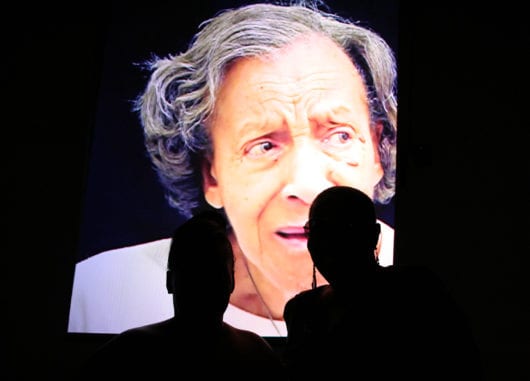
Fig. 2 Active Energy: Pittsburgh. Installation at The Mattress Factory, 2012.
II. GEEZER POWER
THE PROJECT BEGAN AS AN ARTIST residency organised by SPACE in East London, following research at Queen Mary University of London1 that was looking into why the experience of older people was not informing the development of new technologies. Through this I met The Geezers, a self-named group of senior working class men, who gather each week at an AgeUK centre to counter loneliness and isolation. In response to my question as to what technology they would most like to see to support themselves or their community, they identified tidal power. This was due to the fact that older people in their community often cannot afford to heat their homes, while living close to the Thames, a tidal river that in previous centuries had provided power for London’s riverside communities. Following my first visit the group became consumed by the quest to find renewable sources of energy to address the needs of their community.
We started by visiting the nearby Three Mills heritage site to learn how the water wheels of this historic mill had once been used to turn stones for grinding grain. Then, with advice from the Director of Sustainability at University of East London where I was based at that time, we proceeded further with our research. It seemed that funding for tidal technology had been severely reduced in the UK during the Thatcher government of the 1980s, with later development of renewable energy sources focused mainly on wind power. There were no readily available designs for turbines that could respond to the river’s ebb and flow so the group organised community transport to look at locally sited wind turbines that could most easily be adapted for underwater use. A visit to the Thames Flood Barrier revealed a suitable ready-made barrage. At the culmination of the residency, using visual materials gathered in our research, I created a large-scale photomontage of how turbines might function in this location. The piece was displayed in the concluding exhibition at the SPACE gallery in Hackney.
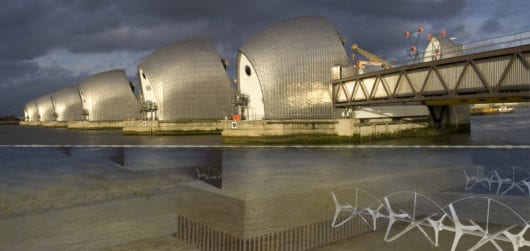
Fig. 3 Visualisation showing how turbines would function on the Thames Barrier, 2008
The group’s new knowledge coupled with their understanding of how these technologies could better support the lives of local people made them highly effective advocates of a sustainability argument. Seeing this I decided to conduct video interviews with The Geezers to accompany the photo-visualisation. These were projected at a large scale to lend authoritative weight to the speakers and their views. The installation’s impact was reflected in significant local press coverage. Despite little public speaking experience, eight members of the group presented the project to great acclaim at an accompanying symposium, On the Margins of Technology. Ironically the heightened public attention had much to do with the very nature of the group’s senior status turning on its head their initial marginalised position.

Fig. 4 Local press coverage, courtesy East London Advertiser, 2008.
III. WHERE ART AND ENGINEERING MEET
AFTER THE EXHIBITION I FOUND a small amount of funding to equip The Geezers with a laptop and other resources allowing them to conduct their own online research and share findings. Group members were enormously engaged in the potential of their idea, which tapped into many of their practical skills and interests. Unprompted, they began to draft new turbine designs and debated how these would work. Engineering expertise presented itself in the form of Toby Borland, a highly creative mechanical engineer who ran a prototyping laboratory at University of East London, and Professor Stephen Dodds, renowned for his development of the control system for the European Space Commission. Both gave freely of their time and knowledge out of interest in the project. SPACE, which had managed the original residency, re-joined the project for similar reasons, raising funds to support intergenerational work with a local school as well as enabling The Geezers to continue work on tidal energy.
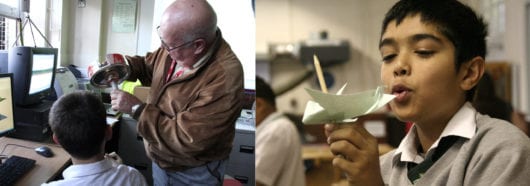
Fig. 5 School workshops with The Geezers as mentors, Bow School 2009.
Through this new arts and engineering collaboration I was able to recruit Toby Borland and Stephen Dodds to lead workshops at these local schools. They were assisted by the previously isolated older men from the Geezers Club who now found themselves mentoring underachieving boys. At the school’s request the work focused on wind power, and so the young people learned about aerodynamics and tested their designs in a makeshift wind tunnel. The best design was then used as a rooftop wind-driven lightwork for the AgeUK centre, which rotated to spell out ‘Geezer Power’.

Fig. 6 Wind turbine on AgeUK centre, Bow, 2010.
IV. TURBINE IN THE THAMES
MEANWHILE, WITH ONGOING SUPPORT from the engineers, design work on a tidal turbine continued. The Geezers developed designs at University of East London’s prototyping laboratory, trying them out in a specialist water tank.
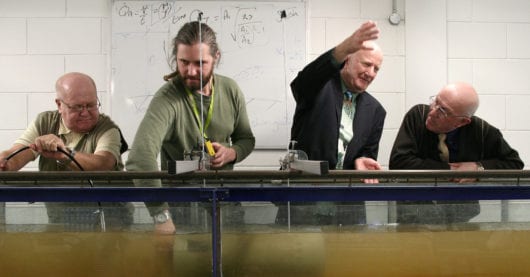 Fig. 7 The Geezers testing turbine efficiency at University of East London, 2010.
Fig. 7 The Geezers testing turbine efficiency at University of East London, 2010.
A suitable Thames riverside site that could support the final prototype had to be found. The owner of a barge that functioned as a bar close to the Houses of Parliament offered use of his vessel. Although testing demonstrated more work was needed, it also identified the device as the first small-scale turbine suitable for use on tidal rivers. Its production from low-cost and recycled materials made the design eminently adaptable for use where cost would be an issue such as in developing countries. All the designs were created to be open source and posted on the Active Energy web site for others to access.
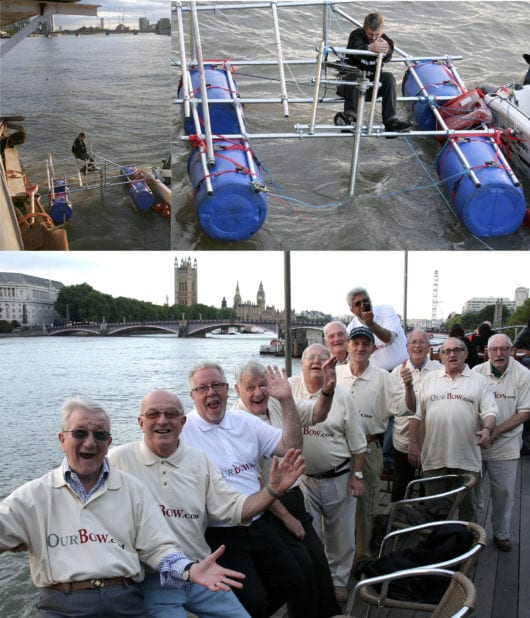
Fig. 8 The Tamesis Dock barge in central London was used as a testing site for the tidal turbine, 2013.
Development of the turbine led to an additional, parallel two-year project with the owner of the turbine-testing barge to explore the dearth of wildlife habitat along the river’s urban reaches. These historic marshlands had been transformed into shored-up concrete banks to enable sufficient depth for river traffic. Lambeth Floating Marsh experimented with the construction of reed beds along the hull of a Thames barge providing an experimental environment where microorganisms and invertebrates could breed and support the river’s food chain. Images of these organisms were then projected along the embankment to bring the issue to public attention.
V. A STREAM WHEEL FOR THREE MILLS
FOLLOWING THIS, THROUGH INVOLVEMENT in the Hydrocitizenship research project that had gained funding from Arts and Humanities Research Council, we were able to extend our remit to address further issues affecting the tidal reaches of the Lea Valley where it joins the Thames. We conducted this work in partnership with Thames21, an organisation that works with communities across Greater London to improve its watercourses for people and wildlife.

Fig. 9 River Lea pollution. Photos courtesy Thames21.
Under certain weather conditions sewers overflow into the River Lea. Effluent bacteria then feeds microorganisms, which take up oxygen in the water suffocating fish. Through workshops with engineer Toby Borland, who had stayed with the project since its early days, we worked out a plan to use the river’s flow to drive an aerator that would pump oxygen into the water.

Fig. 10 Water wheel construction, 2016.
An excellent site for this proved to be close to the nearby historic Three Mills, knowledge of which had in part informed our understanding of water power at the commencement of the project. Due to the extensive tidal range at this location—at its lowest ebb less than a metre in depth—we arrived at the idea of a floating water wheel, rather than a turbine, that could rise and fall with the tide. A ‘stream wheel’ was designed and located in a tidal basin where its blades would catch the outflow of the pool feeding the18th century mill, currently out of use. As the blades turned they drove a pump helping to aerate the water. Its launch in 2017 provided another opportunity for AgeUK to raise awareness of the value of the older population to wider society.
 Fig. 11 Floating water wheel at Three Mills, Bow, 2017
Fig. 11 Floating water wheel at Three Mills, Bow, 2017
VI. ACTIVE ENERGY IN THE OLYMPIC PARK
IN 2019, FUNDED BY MIDDLESEX UNIVERSITY and supported by Canal and River Trust, a second water wheel was created for the Waterworks River in the Queen Elizabeth Olympic Park, further upstream in the River Lea complex. Its installation, supported by funding from the National Lottery, was accompanied by workshops with science students at a secondary school located on the river and engineering students at a college of further education. Participants visited the wheel in situ and learned about the need for sustainable forms of energy to help counter climate change as well as the ecological challenges for their local rivers. In group workshops working models of turbines suitable for the generation of renewable energy were created.
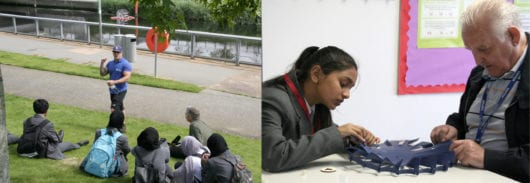
Fig. 12 Workshops, 2019.
These were showcased at an event supported by the London Legacy Development Corporation, held during a week of world action for climate justice. Here participants engaged in public debate with representatives of the Greater London Authority and environmental and campaigning organisations to consider what was necessary to bring about environmental change locally and globally.
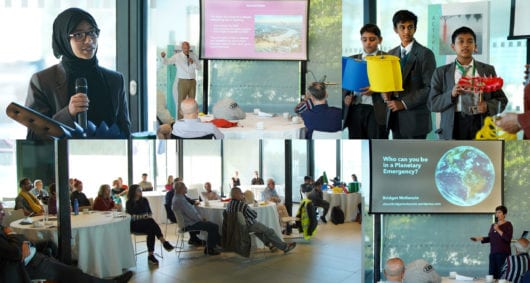 Fig. 13 Public event, 2019.
Fig. 13 Public event, 2019.
VII. ART AND SOCIAL CHANGE
THE SCHOOL, COLLEGE, AND environmental trust involved in the final stage of the project will use the Active Energy learning materials in their future curricula. The Geezers have been liaising with the housing association responsible for sheltered housing in their neighbourhood to incorporate renewable forms of energy into its new-build properties. They have contributed their knowledge to three university research initiatives, inspired a seniors’ group in Pittsburgh to develop a project of their own, collaborated with another community group in the North of England and presented their ideas on many occasions at public events and to the media. These activities are communicated locally via frequent posts on their own blog as well as through the project website and numerous books, journals and magazine articles. While Active Energy has achieved all this, it is nevertheless an arts initiative and not positioned to institute new technological developments. However, what art like this can do is empower communities to address politicians and decision-makers about issues that affect them, while deepening and broadening debate amongst those who have been less involved.
In this project new collaborations have led to the creation of artefacts that have in turn brought public attention to urgent issues The Geezers wished to address. This kind of approach takes time and requires constant fundraising and excavation of opportunities to enable progress. Active Energy typifies the organic way in which such projects can gain longevity if they are rooted in community and not subject to the overarching constraints of commissions or funding bodies. By patching together funding and resources, despite the work it entails, projects such as this can respond to need and opportunity. Through its support of concerns identified by senior citizens in East London, Active Energy found itself addressing urgent ecological issues and discovering new ways that crucial local knowledge can have an effect both locally and with a constituency far beyond its own borders.
FOOTNOTES
- Democratising Technology (DemTech – www.demtech.qmul.ac.uk) was a UK research project that involved a number of community groups to ask whether together a generative, open-ended form of engagement with digital technology could be produced and brought to bear on the design of our society and its tools. It worked with participants’ values and aspirations for the future, using arts development methods as a transformational tool.
NOTES
Further information can be found at http://www.active-energy-london.org
All photos and images are by the artist unless otherwise indicated.
